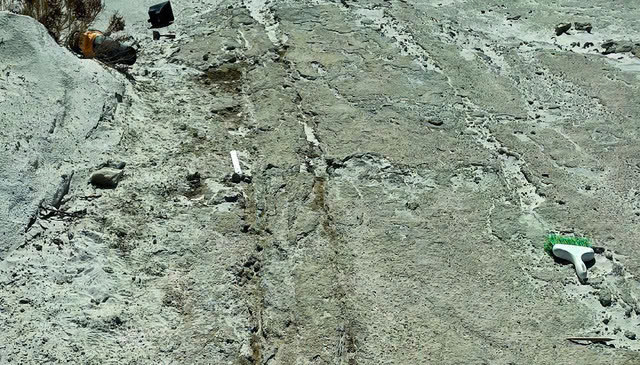Ancient drag marks discovered alongside human footprints at White Sands National Park reveal that humans were using primitive transport technology thousands of years earlier than previously thought. This groundbreaking find challenges our understanding of early human settlements in North America and showcases the ingenuity of our ancestors.
The Remarkable Discovery at White Sands
In May 2023, archaeologists led by Professor Matthew Bennett from Bournemouth University made a stunning discovery in the heart of New Mexico’s White Sands National Park. While excavating an area already famous for its ancient footprints dating back over 23,000 years, the team unearthed distinctive drag marks extending up to 50 meters (165 feet) alongside human footprints.

These marks weren’t random scratches in the dried mud—they were evidence of something being deliberately pulled across the landscape. Further investigation revealed these to be the oldest known traces of a travois, an A-shaped wooden transport device used by early humans to move heavy loads.
What Is a Travois?
A travois consists of two wooden poles tied together to form a simple sled-like structure. While Indigenous groups in North America, particularly those in the Great Plains, are known to have used this design for centuries—often with dogs or horses as the pulling power—this discovery pushes back the origin of such technology by thousands of years.

This simple yet effective design represents a critical innovation in human history, predating wheeled vehicles by millennia and demonstrating the problem-solving capabilities of our ancestors who needed efficient ways to transport food, tools, and other essential items across challenging terrain.
Human Footprints Tell a Family Story
Alongside the drag marks, researchers found adult and children’s footprints, painting a picture of family groups traveling together. The presence of children’s tracks suggests that families worked collectively to move important resources, much as they might today.
These combined footprints and drag marks offer a rare window into daily life over 20,000 years ago, showing that early North American settlers had already developed effective transport methods long before the domestication of animals like horses or oxen.
Confirming the Theory Through Replication
To validate their findings, Bennett’s team conducted experimental archaeology by building their own travois and dragging it across mudflats in the United Kingdom and along the Maine coast in the USA. The marks created in these experiments closely matched the fossilized tracks found at White Sands, providing compelling evidence for their interpretation.

This hands-on approach helped confirm that the ancient marks were indeed created by human-pulled transport devices, further supporting the theory that early inhabitants of North America were using sophisticated methods to move goods across the landscape.
Challenging the Timeline of Human Migration
A New Chapter in the Story of North American Settlement
One of the most significant implications of this discovery is its potential to rewrite the accepted timeline of human arrival in the Americas. While conventional wisdom has placed human migration to North America around 15,000-16,000 years ago via the Bering Land Bridge, the White Sands evidence—with dates pushing back to 23,000 years ago—challenges this narrative.

The preservation of these drag marks for over 22,000 years not only testifies to the remarkable conditions at White Sands but also to the technological advancement of people who were traversing the Americas much earlier than previously believed.
Video
The Legacy of Prehistoric Transport
Understanding how early humans moved resources across landscapes provides crucial insight into their survival strategies and social organization. The travois represents an important evolutionary step in transportation technology, laying the groundwork for increasingly complex systems that would develop over thousands of years.

This discovery highlights the resourcefulness and adaptability of early North American settlers, who thrived in challenging environments by developing innovative solutions to everyday problems. Their ingenuity—evident in this simple yet effective transport method—reminds us that human creativity and problem-solving have deep roots in our evolutionary history.
As researchers continue to study these ancient tracks, each new finding helps complete our picture of prehistoric life in North America, connecting us more deeply to the remarkable story of human migration and adaptation across continents and millennia.

